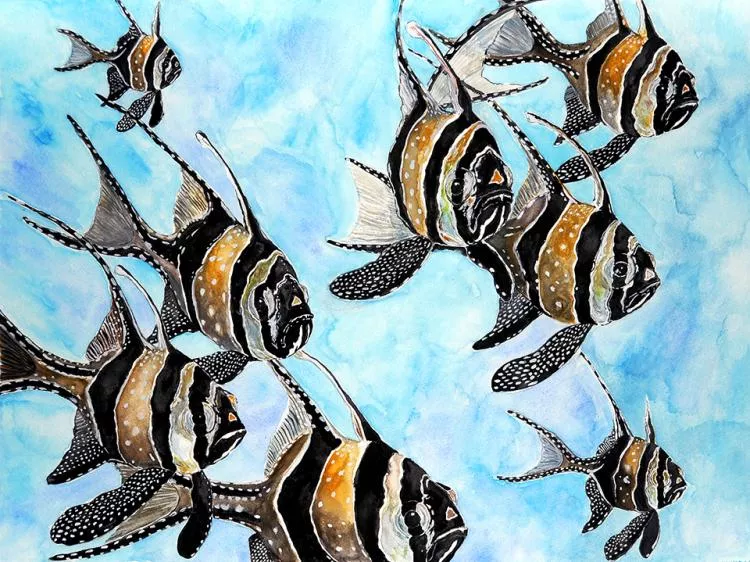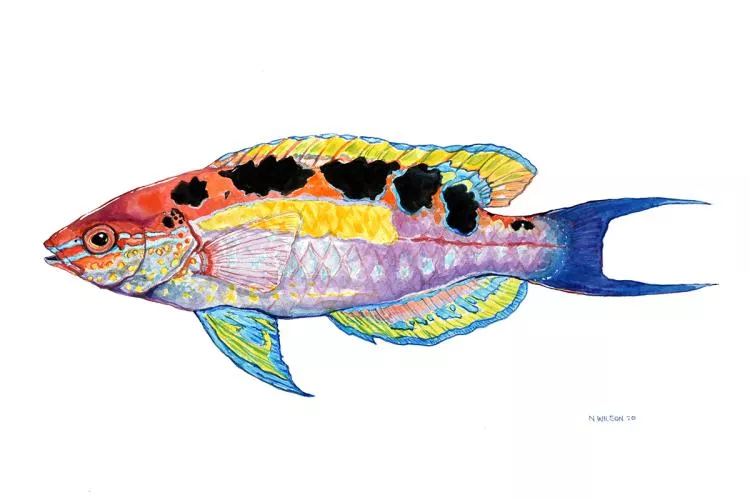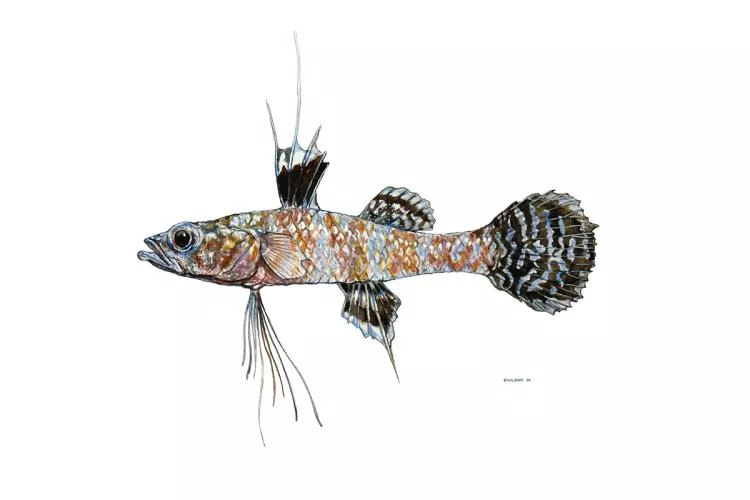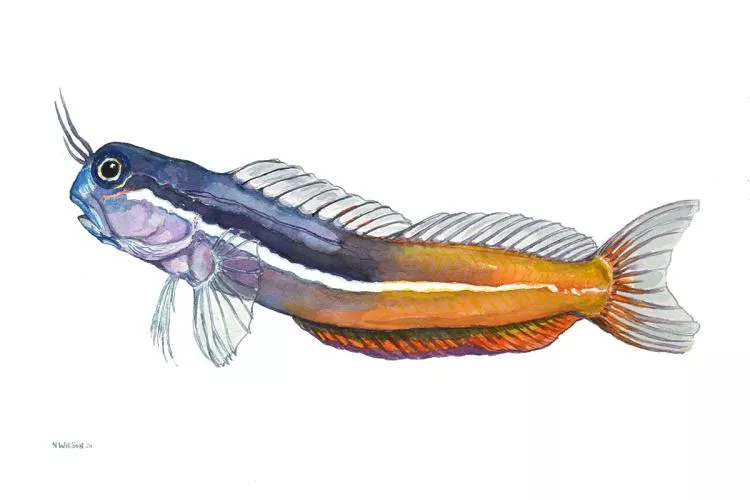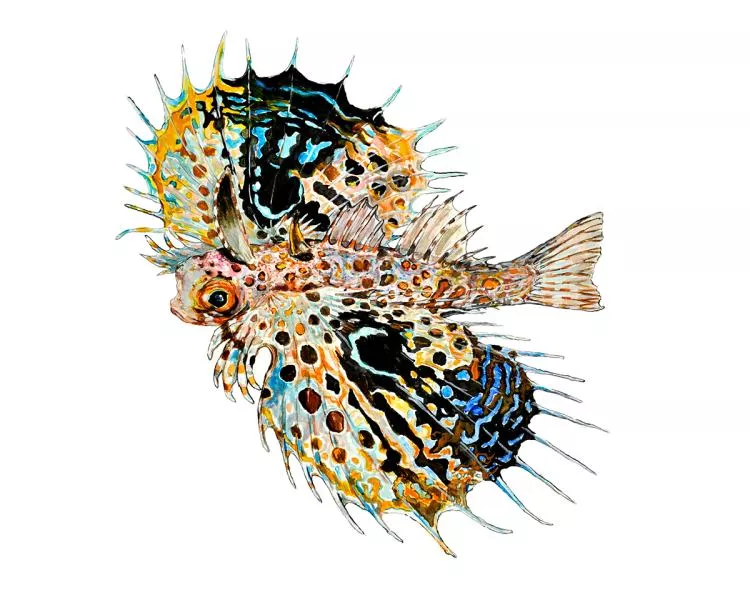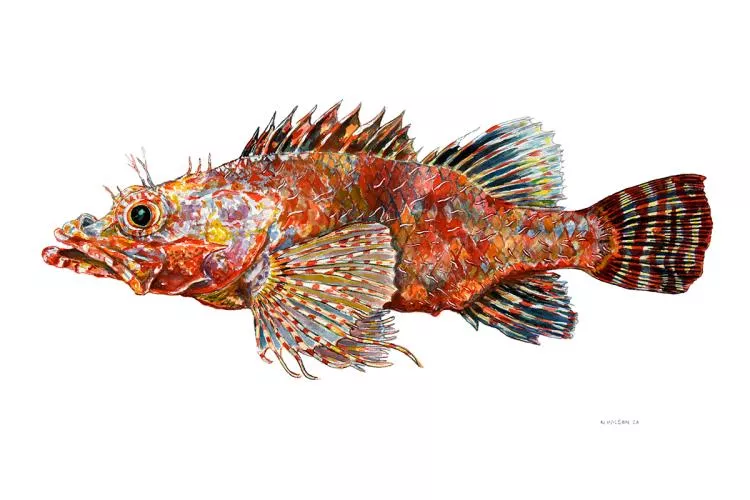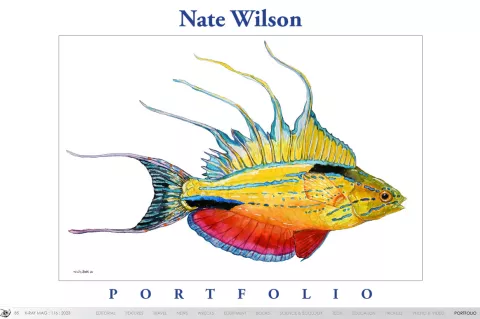American artist Nate Wilson creates beautiful and enchanting watercolor paintings of marine life with great attention to the unique characteristics of each species. X-Ray Mag interviewed the artist to find out more about his artwork and creative perspectives.
Contributed by
X-RAY MAG: Tell us about yourself, your background and how you became an artist.
NW: I grew up in the United States, in Central Pennsylvania. My childhood home was located on the banks of the Juniata River. I spent a lot of time in the water as a kid—swimming, canoeing, inner tubing, snorkeling and catching fish, which I kept in small aquariums. My parents were both art teachers, and I grew up with lots of access to art: trips to museums, tons of art supplies, and just spending time making art. One of my earliest memories is sitting with my dad on the floor and drawing together on a big roll of paper in the evenings.
In high school, I spent most of my day in the art room, in art class or on a pass from another subject. After high school, I got a Bachelor of Fine Arts degree in printmaking from Edinboro University in Pennsylvania, and eventually a Master of Fine Arts degree from Tulane in New Orleans. Much later, I went back to Mansfield University and earned my K-12 teaching certificate in art.
I have made different kinds of art over the years, but it was not until about ten years ago that things really clicked. My wife and I were living in a small apartment, and the space was not conducive to the large-scale art I had been making (things like screen printing, large relief prints, or big acrylic paintings).
I think most artists benefit from having a space specifically for making their art—where they can look at it, think about it, and work on it as new ideas arise. At the time, the area where I could make art was also the kitchen table, so I would not be able to make art consistently because there was no way to leave things out when I was done for the day. Everything had to be put away, so we could use the table to make dinner, eat, etc.
Aside from sketching, making art had become something that I only did if I felt I had a lot of time to work on it. Maybe this is why I did not really feel that I had a lot of connection to the art I was making at that time.
One day, I picked up an old student-grade watercolor set and decided to paint a fish. I had not used watercolor since high school. I had never had actual lessons in watercolor painting or used it more than once or twice. It was a challenge to work with, and I think that made it inviting. As much as it is possible for someone with two art degrees to say they are self-taught in anything, I think that I am self-taught with watercolor.
Because it was also easy to clean up, I found myself painting a lot. I worked in the evenings and nights as a photographer for my local paper. During the day, I would substitute teach. If I did not have a sub job lined up, I would make painting my job for the day, starting when my wife left the apartment and working until just before she came home.
I started painting fish because they seemed suited to the medium, and they were something I connected with because of my continuing interest from childhood. I was also fortunate that I was able to sell a number of my early fish paintings, and that helped challenge and motivate me to continue in this direction.
X-RAY MAG: Why fish and marine life? How did you come to these themes and how did you develop your style of painting?
NW: I have always enjoyed being around water and have been fascinated by fish and marine life. I had a bunch of fish tanks growing up. Some of these were tropical, with fish like guppies and mollies. My family kept goldfish in tanks and a pond. I also had river fish in a 29-gallon tank.
My friends and I would catch all kinds of things in the river below the house. I used to walk upstream and snorkel down the river, past our house. Every trip was different. I really liked observing nature and got a lot of joy out of noticing small things.
I think as I have gotten older, the enjoyment of nature has become a central part of the things I choose to do. I feel that painting fish has been successful for me because it is something that I am truly interested in. I think that I am being honest with myself in what I choose to make and that carries through into the artwork.
As far as my style goes, despite the art degrees, I would say that it reflects that I am self-taught when it comes to watercolors and their application. I try to really look at what it is that I am painting and notice the details. I think art is about perception and translation—showing other people what you see and translating that for them. Obviously, what I do is pretty straightforward, but I enjoy noticing the small things and displaying that knowledge as part of each artwork.
X-RAY MAG: Who or what has inspired you and your artwork and why? What mentors, artists, art styles or movements have influenced your artistic vision?
NW: My parents were a huge influence in that they were very supportive of me making art. After a very young age, they were really hands-off, in terms of showing me specifics. They just let me go.
There were always art supplies in the house, we went to a lot of museums, and they backed my interests. My mother was first up in the mornings and often found dust-covered crayfish, which had escaped my fish tanks, wandering around downstairs.
I enjoy looking at many kinds of art even if it is not specifically relevant to the kind of work that I make. I like cave paintings because it is wonderful to see oneself as part of a tradition of people trying to understand their world through artmaking, which goes back tens of thousands of years. I like to look at street art because I understand that compulsion to make the gray spaces of the world colorful, to make people think, and just that need to make and create.
I like the Japanese woodblock masters like Kuniyoshi and Hokusai, and the skill it took to build their images. I like to think about how the Renaissance masters rediscovered perspective, or how the Impressionists used color. I like the German Expressionists.
As for contemporary artists, I like Okuda San Miguel, Jeff Soto, Skinner, and Swoon. There is so much great and wonderful stuff that has been or is being made. Those are just some examples. I think it is impossible to pick a favorite artist or even a style. In terms of “fish artists working today,” I really enjoy Yusei Nagashima, Karen Talbot, Joe Tomelleri, and Teuthis. Just looking at any of these artists’ works makes me want to start making my own.
X-RAY MAG: What is your artistic method or creative process?
NW: How I make art is pretty straightforward. I have an idea of a species I want to paint. It may be a fish or endemic species from a location, which I just saw something about. There are 30,000+ species of fish, and I am always reading, looking at images and learning new things about fish.
I search for images online, in my own photo library or in my shelves of fish books. I try to get at least seven to ten pictures of a species to look at, and then I pick and choose bits from each. A lot of my fish are painted from the side, but I try to maximize their colors and patterns.
I generally start with a light pencil sketch of the basic shape and pattern. I then work from one end of the fish—usually starting with the face—to the other. I like to build layers of color as I go, and take a lot of breaks to let stuff dry. I usually listen to podcasts while I work.
X-RAY MAG: What is your relationship to the underwater world and coral reefs? How have your experiences underwater influenced your art? In your relationship with reefs and the sea, where have you had your favorite experiences?
NW: In high school, I spent a year as an exchange student in Queensland, Australia. I had always wanted to go there, after seeing an article on the Great Barrier Reef in National Geographic. David Doubilet’s pictures were incredible.
I was able to spend one day on the Great Barrier Reef, off Airlie Beach, as part of a bus trip around half the country with other exchange students. I swam over a wobbegong shark and saw a harlequin tuskfish. Those were animals I had only seen in magazines. That experience blew my mind.
In graduate school, I managed to squeeze a PADI Open Water and Advanced Open Water certification, and a couple of dive trips to the Florida Panhandle, into my school schedule. In 2003, I took a year off and traveled around Australia, New Zealand and Fiji. Since then, my wife and I have been back to the South Pacific six or seven times. I have dived the Great Barrier Reef, Ningaloo Reef (Western Australia), lots of places in Fiji (the Rainbow Reef, between Taveuni and Vanua Levu, being my favorite), Tonga and the Cook Islands.
My top underwater experiences include the time when my wife and I went to Vava’u in Tonga in 2014 to see the whales. On our last day, we were watching a mama humpback and her calf. The calf kept swimming up to check us out and would corkscrew past us, playing, over and over again. This lasted a good 30 minutes.
In the end, the mother cruised by us with her baby. Just looking into her eyes was amazing. I don’t think I am anthropomorphizing when I say she was looking back, actually considering us and what we were.
Another dive I really enjoyed was at a site called Blizzard Ridge on Ningaloo Reef. We were engulfed in a school of baitfish, stretching along an underwater ledge, for a good 20 minutes. Then there was the summer when we spent about five weeks on Taveuni in Fiji. I spent so many hours snorkeling in the tiny lagoon between the beach and the reef edge that I knew where just about every scorpionfish and blenny hid. Every day brought something new. Being able to spend that amount of time in one spot was phenomenal.
And just this past summer, I was thrilled to find sculpin in a tiny creek in Southern Pennsylvania. Really, you could put me anywhere there is water and fish, and I will be happy.
X-RAY MAG: What are your thoughts on ocean conservation and coral reef management and how does your artwork relate to these issues?
NW: I think ocean conservation and reef management are both extremely important. I also think that tackling the global problem of climate change should be a priority for individuals, who can do small things, and governments, which can do large things. I am no scientist, but I think that without addressing climate change, I am not sure how effective reef conservation will be in the long run.
I think that education about the oceans and reefs is very important. People cannot appreciate what they do not know anything about. Without knowledge about an ecosystem, or the problems affecting it, there is no incentive for people to help or change their behaviors. A healthy coral reef is an amazing place with a mind-blowing density of life. I think most people who do not live near a reef, or have never dived or snorkeled on one, have no idea just how special they are.
Aside from education, I think that getting local communities involved with the conservation of their resources is key. Local communities often need an economic reason to conserve the resources near their homes, so providing opportunities to help them transition into conserving these resources is important. Many local communities have traditions of stewardship that can be reinvigorated or expanded. Marine protected areas, with no-take zones and/or managed subsistence fishing, are great ways to help regenerate a marine area.
My hope is that my artwork will show people the beauty and value of every species. The first time I ever saw a mandarin goby, I was amazed at just how much detail and beauty was packed into this tiny living thing. I think about that moment when I paint.
I want my artwork to represent each species like a jewel being presented on a blank background, where its beauty is emphasized by the empty space around it. I am constantly asked by people, looking at my work, if the fish I have painted is real. Hopefully, the realization that the earth is full of things we do not know about or understand, will cause people to dig into their world a little bit deeper.
I have always considered my art to be about conservation, but it was not until about four years ago that I really started to think about what that actually meant and what I needed to do to make art that might change something.
X-RAY MAG: As avid divers, many of our readers are familiar with Bird’s Head Seascape. Please tell us about your Bird’s Head endemic series. How did this series come about? What was most interesting to you about Bird’s Head and why were you drawn to this location? How did you choose the species to paint?
NW: I have known about Raja Ampat and the Bird’s Head Seascape’s biodiversity for a while. The Bird’s Head Series came about because of the coronavirus pandemic. Like many people, I was in lockdown during Covid. The school district I work for shut down in March of the first year of Covid. We began online learning. Things were very uncertain.
To help out families not working, our district began distributing food parcels twice a week. I volunteered to help with this, because I wanted to do something positive and also get out of the house. The end result was that on days that I helped fill food parcels and distribute them, I felt really good. I decided that since I was doing something on a volunteer basis locally, I should try and do something with a more global scope.
So, I made a list of organizations that I would be interested in working with and started to send out emails describing my work as an artist. I expected this to be a lengthy process. The Bird’s Head Seascape seemed to me like it was a place with a number of conservation groups doing a lot of good things and was first on my list.
Burt Jones from the Bird’s Head Seascape website got back to me almost immediately to let me know that he had passed my information on to Dr Mark Erdmann at Conservation International. If you are not familiar with Burt and his wife Maureen, they are excellent photographers (secretseavisions.com), who have written two guidebooks on Bird’s Head and run the Bird’s Head Seascape webpage (birdsheadseascape.com).
Via a Zoom meeting or two, and numerous emails with Dr Erdmann and Marit Miners from Misool Eco Resort/Misool Foundation, we decided that I would paint the fish species endemic to the Bird’s Head Seascape. Images of the paintings have been used by the Misool Foundation to create 52-week planners (calendar booklets), t-shirts and canvas bags. A hundred percent of the profits go to the Misool Foundation to pay for patrols and other conservation activities. The items have been on sale since late September, and with the Bird’s Head reopening to travelers, it will be exciting to see how they take off.
I took the 57 paintings I did and made them into a poster called the “Endemic Species of the Bird’s Head.” I also did another poster for the endemic species of Teluk Cenderawasih National Park, most of which are the same as Bird’s Head. Both these posters have been printed and distributed in a number of government offices.
I donated my artwork to them because I think that conserving the Bird’s Head Seascape is important. Obviously, I would like to see Bird’s Head at some point myself. But I also hope that when the kids I teach get older, places like the Bird’s Head will still be there for them to see.
X-RAY MAG: Did you work from specimens or underwater photographs of the endemic species, and if so, what camera gear did you use?
NW: I have to say that it is really exciting to be able to work with great photos taken by the experts who oftentimes are discovering new species and describing them. Most of the pictures are provided by Dr. Erdmann, taken either by him or Gerry Allen.
Allen uses a Nikon D7000 DSLR camera in a Nexus housing, with 105mm macro lens, and Dr. Erdmann uses a Sony a7R III mirrorless camera in a Nauticam housing, with a 90mm macro lens. I have yet to shoot any images in Bird’s Head… hopefully, next year!
When I do shoot underwater, I use a Nikon D750 DSLR camera in an Ikelite housing or an Olympus TG9 camera in an Olympus housing (for stream shooting, so I don’t have to lug the Ikelite through the woods).
X-RAY MAG: What is the message or experience you want viewers of your artwork to have or understand?
NW: I want viewers to think about each individual animal as something to be marveled at and appreciated. Nature is amazing in and of itself. I would also like for that marvel to spark a discussion of where humans stand in the natural order.
I think, as a species, we have to understand that we are part of the ecosystem and not outside of it. I also think that if there is an animal or an ecosystem that you love, and want it to be there for kids down the road, then you need to try and do something to help it.
I want people to understand that they can make a difference in what goes on in the world. Three years ago, I had nothing to do with the Bird’s Head. It was just a dream destination. But now, because of the creative process that I have been part of, I know a lot more about the endemic species that live there, the reefs, and conservation issues in the region. That has been really enlightening in itself. But I have also gotten to know some very knowledgeable and passionate people through this process.
Today, paintings I made are being used to help fund conservation there. All 57 species I painted are being used on fish ID posters. I hope that it makes at least a small difference. Just being involved is amazing to me, but none of it would have happened if I had not sent an email. Take that first step. You never know what can happen.
X-RAY MAG: What are the challenges or benefits of being an artist in the world today? Any thoughts or advice for aspiring artists in ocean arts?
NW: I think the hardest things are: making art that is honest, maintaining a love for something that you loved as a child (making art), and balancing that love and enjoyment of art with everything that goes into making money from it.
Some benefits of making art, among others, are that you develop the ability to be creative, to make something out of nothing, to share your voice in a visual way. I work with students at ages anywhere from 3 to 14 years old (depending on the school year). My advice is, if you like art and enjoy making it, don’t stop. Don’t listen to people who tell you that “you should not make art,” that “it is silly” or “a waste of time.” If more people learned to express their feelings regularly, we would be a healthier society. Be comfortable with what you like to do.
If you want to get better at art, then make sure you stop and look at it critically from time to time. Give yourself permission to make mistakes, just make sure that you try and learn from them. I try to learn something from each painting I make.
Try to draw or make something every day. This is essential to developing as an artist. You do not need fancy materials to make art. You can draw with a pencil on scrap paper or cardboard, or build sculptures from trash—just make something!
X-RAY MAG: How do people—adults and children—respond to your works?
NW: Sometimes, adults do not believe that what I paint actually exists. I have literally had to open a book and show people pictures of some species before they believed that I was not making something up. I never have that problem with kids.
At school, I get a lot of drawings from kids. It’s not always related to my artwork. Usually, they are drawings of me. They are generally pretty funny. I have been drawn as a pirate, a bear, and one year, a fifth grader drew me as a centaur. I have that one framed.
X-RAY MAG: What are your upcoming projects, art courses or events?
NW: I am doing some more art for Conservation International. I have finished a poster for them of the endemic fishes of Milne Bay in Papua New Guinea. I have done some paintings that will be used for posters called the Walking Sharks of the World and also the Walking Sharks of Indonesia. I have also done some art for the StAR Project, a program to reintroduce zebra sharks back into the Bird’s Head Seascape. See: birdsheadseascape.com
There are a couple of other regions in which I have been looking at the endemic species. I have really gotten into looking at the fish that only come from very specific areas. For example, this past summer, I did not go diving but did some snorkeling in Pennsylvania. I thought I knew quite a bit about the local species, but the first creek I got into proved me wrong. I think I am going to be doing a series on the endangered and threatened species in my own state and then maybe a series of freshwater darters.
I have an art show coming up in December that will be over by the time this comes out. It is my first show since pre-Covid times. I would like to get a couple more shows set up. A show of all the Bird’s Head species would be really cool.
X-RAY MAG: Lastly, is there anything else you would like to tell our readers about yourself and your artwork?
NW: I am always open to discussing new projects or exhibitions, especially if they have a conservation angle. I do commissions as well. You can contact me through my website at: natewilsonpaints.com.

